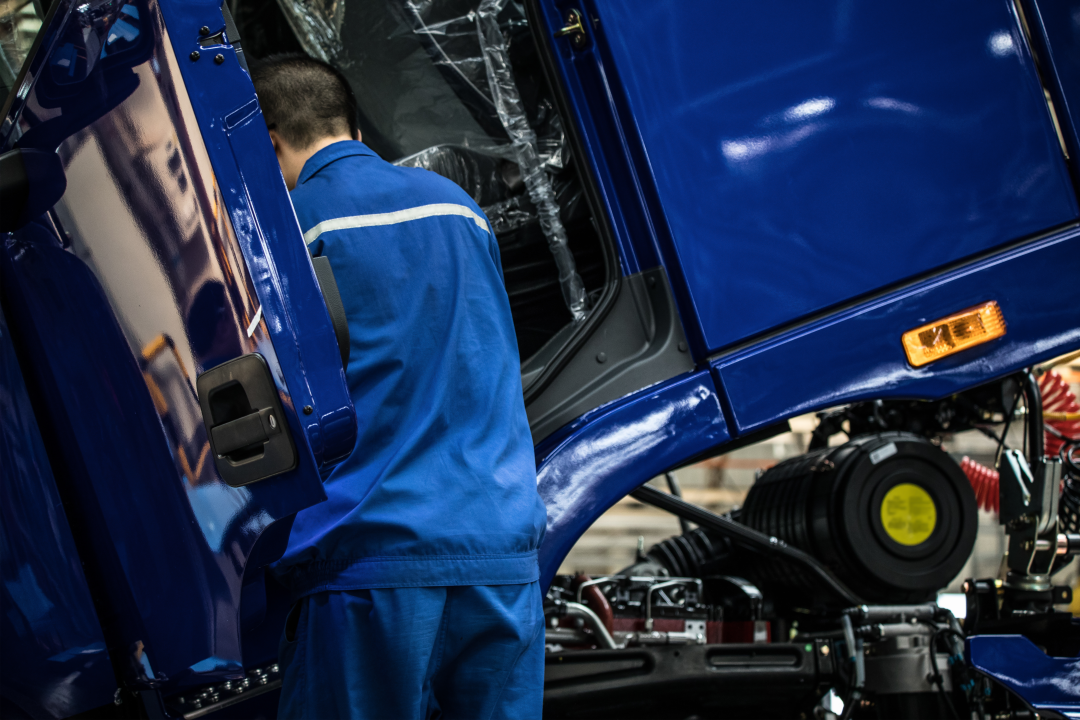
Susie Jones
Kokia parama teikiama neįgaliems sunkvežimių vairuotojams?
Sukurta: 12-08-2024
•
Atnaujinta: 12-08-2024
Jungtinėje Karalystėje 23 % darbingo amžiaus gyventojų nurodė, kad yra neįgalūs - daugeliui nežinant, nemažą jų dalį sudaro sunkvežimių vairuotojai, be galo keliaujantys per Europą, kad pristatytų jūsų prekes. Nepaisant to, kad jie susiduria su daugybe iššūkių, jų buvimas sunkvežimių vairuotojų bendruomenėje pabrėžia įtraukties ir įvairovės svarbą šioje pramonės šakoje.
Ar galiu vairuoti sunkvežimį, jei esu neįgalus?
Jei turite fizinę ar kognityvinę negalią, galite vairuoti sunkiasvorę krovininę transporto priemonę. Tačiau turite praeiti medicininę apžiūrą, kad būtų nustatyta, ar esate pakankamai pajėgus. Medicininę apžiūrą sudaro šie dalykai:
Pokalbis su gydytoju apie jūsų sveikatą: Vairuotojai turi būti sąžiningi ir atviri.
Fizinė apžiūra, kurios metu gydytojas patikrins:
Kraujospūdis
Širdis
Vizija
Diabeto testas
Neurologinės būklės
Miego sutrikimai.
Užpildžiusi šį dokumentą, DVLA nuspręs, ar galite vairuoti.
Sunkvežimių reguliavimas
Vairuotojams, turintiems fizinę negalią, galima pritaikyti šias modifikacijas:
Rankiniai valdikliai vietoj pedalų
Pagalbinės vairavimo priemonės
Kairės kojos akceleratoriai
Sankabos konversija
Pakinktai
Specializuotos sėdynės
Neįgaliųjų vežimėlių laikymo įranga.
2021 m. sunkiasvorių sunkvežimių gamintojas MAN pritaikė keturis sunkvežimius neįgaliems vairuotojams. Pritaikant sunkvežimius buvo įrengta pakeliamoji platforma, kad neįgaliųjų vežimėliais judantys asmenys galėtų lengvai patekti į kabiną - visi valdymo įtaisai buvo įrengti ant vairo arba šalia jo.
Nors technologijos ir pritaikymo priemonės tobulėja, daugelis neįgalių vairuotojų vis dar susiduria su sunkumais darbe.

Su kokiomis kliūtimis susiduria neįgalūs sunkvežimių vairuotojai?
Neįgaliems vairuotojams gali būti sunku įsidarbinti šioje srityje, net jei jie turi reikiamą kvalifikaciją ir yra išlaikę sveikatos patikrinimą. Daugelis įmonių nenori suteikti pritaikytos transporto priemonės, nes tai gali būti brangi investicija.
Vairuotojams, norintiems susimokėti už būtinus pritaikymus, labdaros organizacijos [Globe Truckers UK] (https://www.globetruckersuk.org/) generalinis direktorius Andy teigia, kad vis dar sudėtinga rasti darbą.
"Kai kurios krovinių vežimo įmonės nenoriai įdarbina neįgaliuosius - jos dažnai baiminasi kliūčių, su kuriomis vairuotojai susiduria už kabinos ribų, pavyzdžiui, laiptų ir kėlimo."
Davidas Chambersas, neįgalus sunkiasvorių sunkvežimių vairuotojas, pasisakė prieš išbandymus, su kuriais jis kasdien susiduria, ir paragino tinkamai pritaikyti Lygybės įstatymą, ypač po to, kai vyriausybė paragino daugiau neįgalumo pašalpas gaunančių žmonių grįžti į darbą.
Deividui ir daugeliui kitų žmonių sunku dirbti dideliuose depuose, kuriuose pagal Lygybės aktą depas neprivalo atlikti pagrįstų pritaikymų neįgaliems vairuotojams. Saugumo sumetimais jie turi laukti atokiau nuo savo sunkvežimių, kol vyksta iškrovimas, todėl tenka vaikščioti didelius atstumus ir lipti laiptais.
Kokia parama teikiama neįgaliems sunkvežimių vairuotojams?
Gyvenimą pakeitusių traumų ar ligų ištiktiems žmonėms gali būti sunku rasti paramą. JK labdaros organizacija "Globe Truckers" buvo specialiai sukurta vairuotojų, kad padėtų vairuotojams - ji teikia paramą sužeistiesiems, ligoniams ar neįgaliesiems.
"Daugelis neįgalių ar sužeistų vairuotojų nežino, kur kreiptis, nes informacijos jiems yra labai mažai. Todėl mes siūlome savo pagalbą ir patarimus - ar tai būtų nukreipimas pas reikiamus žmones, ar įrangos finansavimas."
"Kai kuriems vairuotojams tiesiog reikia su kuo nors pasikalbėti, o mes esame čia tam, kad galėtume suteikti jiems visokeriopą pagalbą. Ateityje norėtume turėti galimybę finansuoti sunkvežimių pritaikymą vairuotojams. Pritaikymas gali būti labai brangus, ir dauguma neįgalių vairuotojų už jį turi mokėti iš savo kišenės. Kad tai pasiektume, mums reikia daugiau lėšų ir pramonės atstovų paramos", - teigia Andy.
Kaip pramonė gali padėti?
Pasak Andy'io, norint, kad aplinka taptų įtraukesnė ir įvairesnė, pramonė turi labiau prisitaikyti prie fizinės ir kognityvinės negalios - ir tai turi būti padaryta greitai.
"Labai svarbu, kad pramonės atstovai savo paramą ir laiką skirtų tiesiogiai neįgaliems vairuotojams arba labdaros organizacijoms, tokioms kaip "Globe Truckers". Pramonė negali tikėtis, kad ji bus patraukli žmonėms, jei neteikia paramos mažumoms."
Sunkvežimių stotelės, kurios yra daugelio vairuotojų prieglobstis, gali atverti kelią, nes jose yra pritaikytos patalpos. 2022 m. Vyriausybė investavo 100 mln. svarų sterlingų į šią pramonės šaką, kad pagerintų pakelėse esančią infrastruktūrą ir sukurtų saugesnes sunkvežimių stovėjimo aikšteles.

Gavus vyriausybės finansavimą, būtų galima pagerinti populiarių stotelių prieinamumą neįgaliems vairuotojams. Didelį poveikį galėtų turėti tokie pokyčiai kaip šie:
Neįgaliųjų vežimėliams pritaikytos stovėjimo vietos: vairuotojams, kuriems sunku įlipti į kabiną ir iš jos išlipti, reikia papildomos vietos, ypač tiems, kuriems reikia keltuvo.
Prieinami patogumai: prieinami restoranai, tualetai ir kitos patalpos užtikrina įtraukią aplinką.
Transporto parko įmonės gali padėti kurti įtraukesnę aplinką įgyvendindamos šias priemones:
Sunkvežimių modifikavimas - kad neįgaliems vairuotojams būtų lengviau valdyti sunkvežimius naudojant rankinius valdiklius ir prisitaikančias technologijas.
Parama ir mokymas - kursai, skirti konkrečioms problemoms ar poreikiams spręsti.
Įtrauki įdarbinimo praktika - įdarbinant darbuotojus laikomasi šališko požiūrio, kuris skatina įtraukią ir įvairialypę kultūrą.
Siekiant pritraukti daugiau vairuotojų į krovinių vežimo pramonę, labai svarbu užtikrinti įvairialypę ir įtraukią kultūrą. Pramonės atstovai nepastebi paramos fizinę ir kognityvinę negalią turintiems asmenims, todėl daugelis vairuotojų nežino, kur kreiptis. Neįgalūs vairuotojai pasižymi unikaliu požiūriu ir gebėjimu prisitaikyti, o tai yra sveikintinas pokytis pramonėje.
Ką daryti, jei karjeros metu tapsite neįgalus?
Jei jums išsivysto sveikatos būklė ar negalia, apie kurią reikia pranešti, privalote apie tai pranešti DVLA - DVLA atliks šiuos veiksmus:
Sprendimą priimkite laišku - kai kuriomis aplinkybėmis gali prireikti daugiau informacijos.
Įvertinkite savo sveikatos būklę ir nuspręskite, ką daryti.
Jei jums reikia pritaikyti transporto priemonę, jums reikės nepriklausomo [pritaikymo] įvertinimo (https://www.drivingmobility.org.uk/).
Jei privalote nustoti vairuoti, DVLA pateiks jums medicininę priežastį.



